H-K Models 1/32 B-25J Mitchell
|
KIT #: |
01E1 |
|
PRICE: |
$170.00 SRP |
|
DECALS: |
One option |
|
REVIEWER: |
Tom Cleaver |
|
NOTES: |
Modified to PBJ-1J |
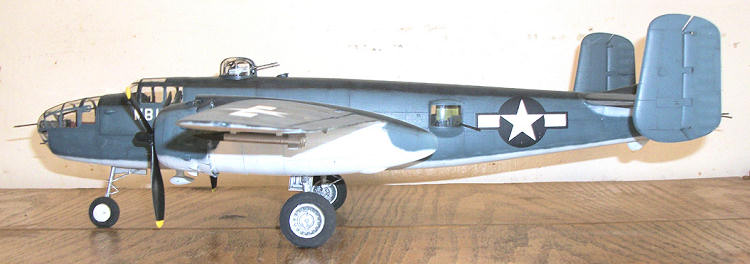
What became the B-25 Mitchell medium bomber originated
in a 1938 Army Air Corps proposal for a twin-engine medium bomber.
The February 1938 proposal from North American aviation
was accepted and followed by the production of the NA-40 prototype, which barely
resembled what became the B-25.
The B-25 is generally considered the best all-around
light-medium bomber of the Second World War.
An efficient yet docile-handling aircraft with good
handling characteristics, it was one of the most popular aircraft among the
aircrews of the several Allied nations that operated the type.
9,816 B-25s were produced, making the Mitchell the
most-produced American twin-engine bomber.
While the USAAF never had more than 2,656 B-25s in
service due to the fact the aircraft was operated by the RAF, the Soviet Air
Force, and several other Allied air forces, it made its mark on every front of
the war world-wide.
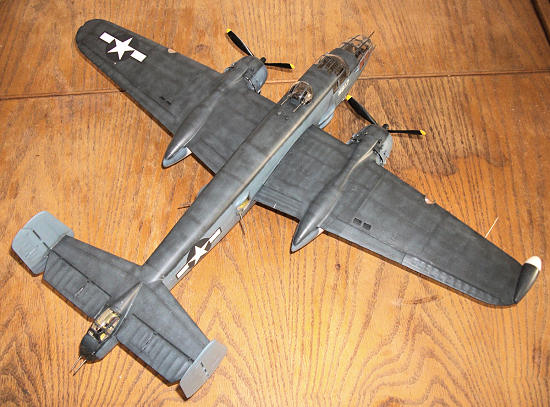 With the loss of the NA-40 prototype during tests in
1939, North American suggested that the meager test reports and the suggestions
of the Air Corps as a result indicated a better aircraft could result from a
redesign.
The resulting NA-62, appearing in 1940, became the B-25.
With the loss of the NA-40 prototype during tests in
1939, North American suggested that the meager test reports and the suggestions
of the Air Corps as a result indicated a better aircraft could result from a
redesign.
The resulting NA-62, appearing in 1940, became the B-25.
The first unit to operate the B-25 was the 17th
Bombardment Group, which re-equipped with the combat-capable B-25B in 1941.
On
December 24, 1941,
a B-25 from the 17th BG became the
first American twin-engine bomber to sink a Japanese submarine.
B-25s were operated during 1942 on coastal
anti-submarine patrols by the USAAF.
In late 1942, the Air Force and the Navy came to an
agreement in which the Navy would assume the responsibility for anti-submarine
patrols in return for the Air Force dropping its opposition to the Navy
operating B-24 and B-25 land-based bombers, which would be used for such
patrols; with this “nose inside the tent,” the Navy went on to operate the B-24
as the PB4Y-1 and the B-25 as the PBJ-1.
The most widely-produced sub-type was the B-25J, with
4,318 being produced at the North American
Kansas City
plant.
Appearing in the summer of 1943, the B-25J remained in production for
the rest of the war.
Known as the PBJ-1J, it equipped Marine Corps bombing
squadrons operating in the Central and South Pacific commencing in late 1944.
VMB-611 - the
Seahorses:
One of six Marine Bombing Squadrons established after
the Navy obtained control of B-25/PBJ aircraft, VMB 611 was commissioned on
October 1, 1943 at Cherry Point, North Carolina, under the command of Lieutenant
Colonel George A. Sarles, an outstanding leader who had seen combat flying the
SBD Dauntless at Guadalcanal in 1942.
Originally equipped with the PBJ-1D (Navy version of the
B-25D), the squadron trained on the
US
est coast until
August 5, 1944,
when they commenced a move to the western Pacific.
This move would become an epic of human survival in the
face of bureaucratic incompetence unlike any experienced by any other American
unit during the entire war.
Half the aircrew flew the 14 PBJ-1Ds to
San Diego,
where they were put aboard the escort carrier USS Manila Bay (CVE-68) for
transport to
Hawaii.
Once
there, they moved to MCAS Ewa.
The ground echelon and the other half of the aircrews
went aboard the SS
Zoella Lykes on
September 26, 1944,
at
Port Hueneme,
California,
bound for
Hawaii
for further transport to the western Pacific to meet up with their air echelon
and take part in the invasion of
Yap.
A change
of orders that the ship did not receive directed them to head for
Emirau
Island
to meet up with the air echelon to participate in invasion of
Leyte.
Instead,
the Zoella Lykes
continued to
Hawaii,
where - without orders - the captain attached his ship to a convoy headed for
Ulithi, with the ship thus dropping into a bureaucratic black hole.
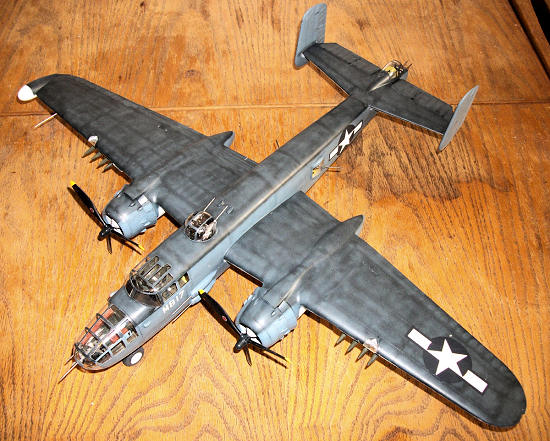 The air detachment, who never knew the rest of the
squadron was sitting in
Pearl Harbor
while they operated from MCAS Ewa, departed
Hawaii
on October 27 for an island-hopping trip to Emirau, where they arrived on Octoer
27, 1944.
With ground and maintenance support from the other two Marine
Bombing Squadrons - VMB 413 and 423 - with the aircrews forced to fuel and
service their own aircraft while Colonel Sarles kept up the search for his
missing aircrew and ground echelon.
Zoella Lykes
had arrived at Ulithi on
November 5, 1944,
and rode at anchor in a remote part of the harbot where the squadron personnel
were able to watch Task Force 38 come and go while food ran out and they were
forced to escape from the ship and steal supplies ashore.
Eventually, Sarles discovered the
Zoella Lykes was still at Ulithi.
On
December 24, 1944,
Sarles led his aircraft on a liberation mission to Falalop island in Ulithi.
Unfortunately, only the air echelon could be taken.
With eleven men crammed into each PBJ, the aircraft
began their takeoffs from the 3,200 foot field on Falalap with the tail hanging
over the water at one end of the runway; they used every inch to get off before
going into the sea at the other end of the runway, retracting their gear with
the props throwing up water spray as they flew low over the harbor to make their
getaway.
The
Zoella Lykes continued its bizarre voyage with
the ground echelon still aboard, finally directed to join a convoy headed for
the
Philippines
in mid-January 19145.
The ship arrived at
Lingayen Gulf
in Northern
Luzon
on February 7, 1945.
Because of the lack of orders, the VMB 611 ground
personnel did not leave the ship until
February 24, when it was discovered the squadron was to
be transferred to Mindoro at the other end of the Philippine Archipelago.
Going aboard two LSTs, they made their way to Mindoro,
where they arrived on March 7, to discover the squadron was to be based at
Zamboanga, Mindanao, where they finally disembarked on March 17, 1945, after a
hellish trans-Pacific voyage lasting nearly six months.
Colonel Sarles led his squadron, by now equipped with
new PBJ-1J bombers, to Zamboanga and the unit was reunited on March 30, 1945.
The air detachment, who never knew the rest of the
squadron was sitting in
Pearl Harbor
while they operated from MCAS Ewa, departed
Hawaii
on October 27 for an island-hopping trip to Emirau, where they arrived on Octoer
27, 1944.
With ground and maintenance support from the other two Marine
Bombing Squadrons - VMB 413 and 423 - with the aircrews forced to fuel and
service their own aircraft while Colonel Sarles kept up the search for his
missing aircrew and ground echelon.
Zoella Lykes
had arrived at Ulithi on
November 5, 1944,
and rode at anchor in a remote part of the harbot where the squadron personnel
were able to watch Task Force 38 come and go while food ran out and they were
forced to escape from the ship and steal supplies ashore.
Eventually, Sarles discovered the
Zoella Lykes was still at Ulithi.
On
December 24, 1944,
Sarles led his aircraft on a liberation mission to Falalop island in Ulithi.
Unfortunately, only the air echelon could be taken.
With eleven men crammed into each PBJ, the aircraft
began their takeoffs from the 3,200 foot field on Falalap with the tail hanging
over the water at one end of the runway; they used every inch to get off before
going into the sea at the other end of the runway, retracting their gear with
the props throwing up water spray as they flew low over the harbor to make their
getaway.
The
Zoella Lykes continued its bizarre voyage with
the ground echelon still aboard, finally directed to join a convoy headed for
the
Philippines
in mid-January 19145.
The ship arrived at
Lingayen Gulf
in Northern
Luzon
on February 7, 1945.
Because of the lack of orders, the VMB 611 ground
personnel did not leave the ship until
February 24, when it was discovered the squadron was to
be transferred to Mindoro at the other end of the Philippine Archipelago.
Going aboard two LSTs, they made their way to Mindoro,
where they arrived on March 7, to discover the squadron was to be based at
Zamboanga, Mindanao, where they finally disembarked on March 17, 1945, after a
hellish trans-Pacific voyage lasting nearly six months.
Colonel Sarles led his squadron, by now equipped with
new PBJ-1J bombers, to Zamboanga and the unit was reunited on March 30, 1945.
 VMB-611 flew their first Philippine combat mission on
April 5, 1945, with six PBJs taking off to attack the Del Monte airfield.
Lieutenant Robert F. Jardes remembered the mission thus:
VMB-611 flew their first Philippine combat mission on
April 5, 1945, with six PBJs taking off to attack the Del Monte airfield.
Lieutenant Robert F. Jardes remembered the mission thus:
“We dropped on the deck as we approached Del Monte and
in the finest traditions of aerial attack we came at the target out of the
rising sun. I saw a truck barreling down the road to the airfield.
Each airplane test-fired their nine forward-firing guns
against this truck with a few hundred rounds of .50 caliber, and when I flew
over it as number six, it was burning fiercely.
Over the field we spotted a white truck parked in the
middle of the runway.
Flying low down the runway I spotted the fact it had no
tires and was sitting on logs, a set-up for hidden anti-aircraft guns, and
warned the others.
We proceeded to shoot up everything else on the field,
leaving the white truck untouched.
Finally a bullet entered my open window and exited
through the windshield, convincing me the Japs had the range and it was time to
depart.
When we returned to Zamboanga, we discovered all six airplanes had been
holed multiple times, with one taking a hit in the starboard fin from a 90mm
shell. Colonel Sarles questioned us about what we’d accomplished in return for
this damage.
After a long moment while we tried to remember what exactly had
happened, one gunner spoke up. ‘Well, sir, we got this one truck for sure.’”
Over a period of two months while Mindanao was secured,
VMB-611 put in a stirring performance in supporting operations, striking
shipping and other Japanese bases in the region to isolate Japanese forces still
fighting on the island.
All was not fighting.
In May 1945, the famous night club comic Joe E. Brown
visited for several days, and went on a flight with Colonel Sarles and his crew.
Brown had been tireless throughout the war in traveling
anywhere to entertain flyers, following the death of his son in a flight
training accident in 1941.
Colonel Sarles was killed on May 30, 1945, when his
aircraft hit the ground in a low-level strafing attack.
For the men of VMB-611, his replacement, a man
remembered by the originals of VMB-611 to this day as “Major A$$hole”, failed to
fill the Colonel’s shoes and morale suffered as a result (at the one squadron
reunion he attended in the 1970s, his reception was so cold the man beat a
retreat after less than 30 minutes). In the two months left of the war, those
originals not transferred put their efforts into surviving the poor leadership
of men trying to get their “ticket punched” for postwar promotion, at the cost
of many dead due to what was seen by the combat crews as incompetence.
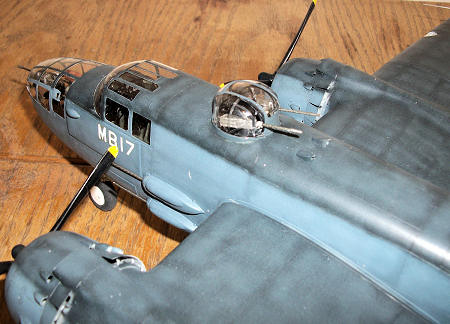 Perhaps
the strangest mission was that flown on August 10, 1945, five days before the
end. Japanese Lieutenant Minoru Wada of the 100th
Division had been captured, and volunteered to lead the squadron to the division
headquarters.
Put aboard a PBJ, the Lieutenant, a graduate of the Japanese Army
Military Academy, was as good as his word and the jungle headquarters was
destroyed.
Perhaps
the strangest mission was that flown on August 10, 1945, five days before the
end. Japanese Lieutenant Minoru Wada of the 100th
Division had been captured, and volunteered to lead the squadron to the division
headquarters.
Put aboard a PBJ, the Lieutenant, a graduate of the Japanese Army
Military Academy, was as good as his word and the jungle headquarters was
destroyed.
When the end of the war was announced, two of the few
surviving original pilots still with the squadron - Captain Jardes and his
co-pilot Lieutenant LeMasters - went to the officers mess and bought every
bottle of whiskey they could, returning later to steal more.
They took their treasure to the enlisted ground crews
and made sure the men finally had their only party since leaving Hawaii on the
Zoella Lykes.
As Jardes put it, “I had a special affection for the
mechanics, who had the hardest, dirtiest and most important job of all.
If the guns don’t work, you pull off and go home; if the
bombs don’t drop, you turn around and go home.
But if the fans don’t turn, you don’t go anywhere.”
VMB-611 returned to San Diego in October 1945 and was
disbanded, ending the Marines’ association with the PBJ, which every man who
flew them felt were the best airplanes they’d ever flown.
The main difference between this production kit and the
test shot reviewed earlier is that the parts are numbered on the sprues, and a
very useful and logical set of instructions are included, which make the project
much easier than my first guessing game with these excellent kits.
Decals for one airplane are included, which are not up
to the quality of the rest of the kit.
I have been told the company plans some later releases
of this kit with better decals from sources all will applaud when they see them.
There are also photoetch seat belts provided; these are
not that good, but once on the seat and inside the canopy, they are more than
adequate for the purpose.
As stated above, having a good set of instructions and
numbered parts made this entire project not that much more difficult than
building a Monogram B-25.
All parts fit very precisely; if one takes care in
assembly, there will be very little seam-filler needed, and that which you will
use will be minimal.
The instructions are clear and my only advice in
building the kit is to study them and then follow them.
If you do this, all will be fine at the end.
 The B-25 is a notorious tail-sitter as a model.
Terry Dean has scaled up his cast metal weights from the
1/48 kit.
I found using two of these under the cockpit was more than enough
to guarantee nose-sitting.
There is plenty of room under the cockpit floor for
this, and they will not be seen through the crew access tunnel if you paint the
forward end of the weight black.
I built the kit in four sub-assemblies: fuselage, tail
empennage, left and right wings.
For those who worry about where to keep one of these
very substantial models once completed, I can suggest that if you leave the
model in these four sub-assemblies, with the main gear glued in place in the
engine nacelles, you can store the model this way and assemble it for display as
necessary.
The wings and tail fit tightly enough to the fuselage that glue
is not necessary.
The separate gun barrels can be kept in a small plastic
bag and inserted in position as needed.
If you trim the brace for the nose gear so it can go
into the opening, you can leave off the nose gear and only attach it when
displaying it.
The top turret can be kept separate and installed when displayed
without problem.
The props can be attached without problem when setting the model
up for display and can be removed for safe storage.
In fact, this review model is displayed in the photos
here assembled in this manner.
Once it goes to Planes of Fame for display in a few
months, it will be glued together for permanence (and the gun barrels won’t be
at strange angles).
The B-25 is a notorious tail-sitter as a model.
Terry Dean has scaled up his cast metal weights from the
1/48 kit.
I found using two of these under the cockpit was more than enough
to guarantee nose-sitting.
There is plenty of room under the cockpit floor for
this, and they will not be seen through the crew access tunnel if you paint the
forward end of the weight black.
I built the kit in four sub-assemblies: fuselage, tail
empennage, left and right wings.
For those who worry about where to keep one of these
very substantial models once completed, I can suggest that if you leave the
model in these four sub-assemblies, with the main gear glued in place in the
engine nacelles, you can store the model this way and assemble it for display as
necessary.
The wings and tail fit tightly enough to the fuselage that glue
is not necessary.
The separate gun barrels can be kept in a small plastic
bag and inserted in position as needed.
If you trim the brace for the nose gear so it can go
into the opening, you can leave off the nose gear and only attach it when
displaying it.
The top turret can be kept separate and installed when displayed
without problem.
The props can be attached without problem when setting the model
up for display and can be removed for safe storage.
In fact, this review model is displayed in the photos
here assembled in this manner.
Once it goes to Planes of Fame for display in a few
months, it will be glued together for permanence (and the gun barrels won’t be
at strange angles).
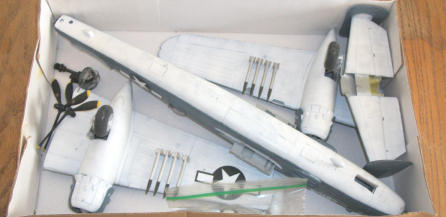 One thing I found necessary to be able to do this is to
narrow the tabs above and below the wing attachment tabs on the fuselage, so the
wing can slide back into position for display without having to use so much
force one would risk injury to the model doing this more than once.
I used rockets from a Trumpeter P-47 kit, with the
launch racks done with Evergreen strip.
The wingtip radome was done using a 75-gallon drop tank
from the same Trumpeter spares.
This is not quite right in outline, but it is “close
enough” for display at Planes of Fame.
I am sure some enterprising after-market company will
come up with a properly-shaped radome in the future for those who want to do the
seagoing Mitchell.
The engines are the proverbial “models in themselves”
and if one wanted to add just a bit of additional small detail, and leave the
cowlings open, this would look very good.
The bomb bay is also highly detailed and I am sure most
modelers will build this kit and display it with the bomb doors open.
I closed things up for display out at Chino, to avoid
future breakage.
One thing I found necessary to be able to do this is to
narrow the tabs above and below the wing attachment tabs on the fuselage, so the
wing can slide back into position for display without having to use so much
force one would risk injury to the model doing this more than once.
I used rockets from a Trumpeter P-47 kit, with the
launch racks done with Evergreen strip.
The wingtip radome was done using a 75-gallon drop tank
from the same Trumpeter spares.
This is not quite right in outline, but it is “close
enough” for display at Planes of Fame.
I am sure some enterprising after-market company will
come up with a properly-shaped radome in the future for those who want to do the
seagoing Mitchell.
The engines are the proverbial “models in themselves”
and if one wanted to add just a bit of additional small detail, and leave the
cowlings open, this would look very good.
The bomb bay is also highly detailed and I am sure most
modelers will build this kit and display it with the bomb doors open.
I closed things up for display out at Chino, to avoid
future breakage.
 I preshaded the model first.
The model was then painted in the Navy tri-color scheme
using Tamiya “Flat White,” “Medium Blue” and “Sea Blue,” with the Sea Blue
“faded” using Tamiya “Field Blue” and then white, while the Medium Blue was
lightened with white to simulate tropical sun fading.
I preshaded the model first.
The model was then painted in the Navy tri-color scheme
using Tamiya “Flat White,” “Medium Blue” and “Sea Blue,” with the Sea Blue
“faded” using Tamiya “Field Blue” and then white, while the Medium Blue was
lightened with white to simulate tropical sun fading.
I used the kit decals for the national insignia, and
found the letters for “MB-17" in the decal dungeon.
I attached the main gear, and attached the nose wheel to
the nosewheel leg. The model will be weathered with exhaust stains and “dings”
before it goes on display.
Having now had the opportunity to do two of these
excellent kits, I can say that in my opinion, this is the best B-25 Mitchell
model available in any scale.
For those who want a different look for their kit,
aftermarket decals are now available from at least
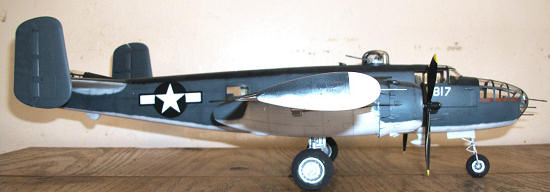 two decal designers and more
are likely on the way. While this kit is a complex model, it is not complicated,
and is well within the skill level of any moderately-experienced modeler who
wants to take the time to assemble it.
For those who worry about cost, consider that it would
be very easy to spend several months detailing what is provided here, with the
ultimate result of creating a show-stopper.
Considering the fun of such a project, the price spread
over that time becomes quite reasonable.
For those who complain that there is no “internet
discount,” consider that the price structure from Pacific Coast Models and the
other distributors in other countries allows your Local Hobby Shop to order the
kit and stock it; your “discount” of this kit should you choose to “support your
local hobby shop” is the not-inconsiderable shipping price you won’t be paying
had you ordered
online.
For what is in the box, $170 is cheap and demanding a
lower price is to ask for something to be sold for less than the cost of
production, which isn’t going to happen.
The kit is highly recommended to those who love the B-25
Mitchell.
two decal designers and more
are likely on the way. While this kit is a complex model, it is not complicated,
and is well within the skill level of any moderately-experienced modeler who
wants to take the time to assemble it.
For those who worry about cost, consider that it would
be very easy to spend several months detailing what is provided here, with the
ultimate result of creating a show-stopper.
Considering the fun of such a project, the price spread
over that time becomes quite reasonable.
For those who complain that there is no “internet
discount,” consider that the price structure from Pacific Coast Models and the
other distributors in other countries allows your Local Hobby Shop to order the
kit and stock it; your “discount” of this kit should you choose to “support your
local hobby shop” is the not-inconsiderable shipping price you won’t be paying
had you ordered
online.
For what is in the box, $170 is cheap and demanding a
lower price is to ask for something to be sold for less than the cost of
production, which isn’t going to happen.
The kit is highly recommended to those who love the B-25
Mitchell.
Tom Cleaver
March 2012
Review kit courtesy
of H-K Models.
Order yours in North America from Pacific Coast Models:
http://www.pacmodel.com
Thanks to If you would like your product reviewed fairly and fairly quickly, please contact the editor or see other details in the
Note to
Contributors.
Back to the Main Page
Back to the Review
Index Page



 The air detachment, who never knew the rest of the
squadron was sitting in
The air detachment, who never knew the rest of the
squadron was sitting in 

 The B-25 is a notorious tail-sitter as a model.
Terry Dean has scaled up his cast metal weights from the
1/48 kit.
I found using two of these under the cockpit was more than enough
to guarantee nose-sitting.
There is plenty of room under the cockpit floor for
this, and they will not be seen through the crew access tunnel if you paint the
forward end of the weight black.
The B-25 is a notorious tail-sitter as a model.
Terry Dean has scaled up his cast metal weights from the
1/48 kit.
I found using two of these under the cockpit was more than enough
to guarantee nose-sitting.
There is plenty of room under the cockpit floor for
this, and they will not be seen through the crew access tunnel if you paint the
forward end of the weight black. One thing I found necessary to be able to do this is to
narrow the tabs above and below the wing attachment tabs on the fuselage, so the
wing can slide back into position for display without having to use so much
force one would risk injury to the model doing this more than once.
One thing I found necessary to be able to do this is to
narrow the tabs above and below the wing attachment tabs on the fuselage, so the
wing can slide back into position for display without having to use so much
force one would risk injury to the model doing this more than once.

